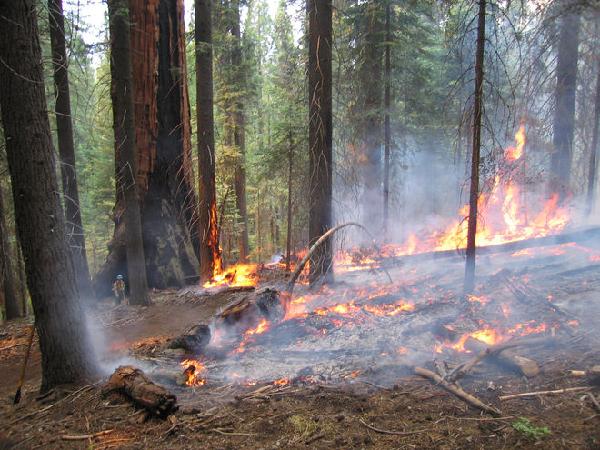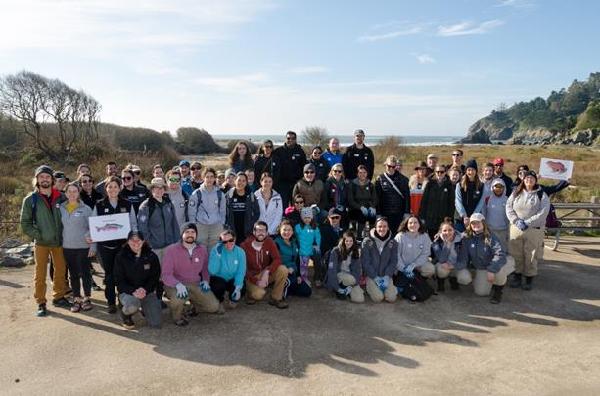|
Fired up for February!
Marin Park Stewardship's February 2017 Newsletter
|
Dear Friend,
February is firing up to be an exciting month, as we will be finishing up our planting season! The Marin Park Stewardship team has been discussing the role of fire in ecosystems and in managing our parks, and we hope this newsletter can shed some light on these topics. Marin Park Stewardship is sending you warmth as we get through this rainy winter season!
In This Newsletter
Flame and Fortune: How Plants Prosper From Fire
By Kathryn Tisshaw
Many ecosystems—particularly prairies, savannahs, chaparrals, and coniferous forests—have evolved with fire as an essential contributor to habitat vitality, quality, and vigor. Specifically, plants have adapted to fire in many ways and some even need fire to survive. We often hear about firefighters working on fire suppression, but there is less talk of the many professionals working on fire promotion for the sake of ecosystems that need it. I have had the opportunity to work with some fire ecologists first-hand, and even participated in fire promotion, or prescribed fires.
Fire ecologists and land managers use prescribed fires as a way to manage ecosystems that historically have been shaped by natural wildfires. Without fires, trees can become overcrowded, flammable fuels can build up and become dangerous, species that need fire to reproduce will disappear, and shrubs will overcrowd the underlying herb layer, thus shading out important flowering plants from the ecosystem.

|
| A low-intensity fire burning the understory of a giant sequoia (Sequoiadendron giganteum) stand. Photo retrieved from: http://www.livescience.com/ |
The U.S. Forest Service actually suppressed fires until they realized that the practice leaves important chemicals and minerals that help plant seeds know when to germinate. Researchers have found that certain plants actually have greater germination success from seed when exposed to fire, or even when exposed to only the smoke from fire.
Fire can burn the seed coat so that the plant can break through easier, but we are still trying to figure out why smoke benefits some plants. It may send some kind of signal to other proteins in the seed to tell it to germinate. Scientists from the University of California-San Diego found that a special protein called a Karrikin is produced when some trees and shrubs burn—though we are not sure if the protein is produced from the fire or smoke. These proteins actually bind to the seeds of these shrubs and trees, triggering a change in shape in the proteins. The new shape sends a signal to other proteins in the seed that stimulates seed germination.
Giant sequoia trees have serotinous cones, which is a fancy word for seeds that open due to an environmental trigger, such as fire. Serotinous cones hang on a tree and remain closed unless a fire sweeps through the ecosystem, melts the resin that holds the cone together, and releases the seeds.
Fire scars in the tree rings of California sequoias date back to 2,500 years ago. Before settlers arrived, these sequoias endured fires every five years, either ignited by lightning or Indigenous people managing the land. These were low-burning fires, which created space in the understory by eliminating overcrowded shrubs while leaving the trees unharmed.
There are many angles land managers need to consider in maintaining these ecosystems. It is important to burn these stands with low-intensity fires to reduce the fuel buildup that comes along with fire suppression. However, with such a large urban population along the coast in California, prescribed burning causes much controversy and intense monitoring is required.
For more information regarding fires in the national parks, please visit: https://www.nps.gov/fire/wildland-fire/about.cfm
Fire Management in Golden Gate National Recreation Area
By Rebecca Natoli
Fire management has always been a valuable tool throughout the Bay Area, playing an important role in the ecological and cultural systems of the region. Historically, burning by the Native Americans—and later a combination of burning and grazing by the Euro-American settlers—have helped shape the grasslands in Marin County. Awareness of both the historical and current uses of fire, along with the negative and positive impacts that fire can have on the region, is important to understand because proper fire management policies and practices allow us to better manage our parks’ natural resources and protect communities, both human and biological.
The Golden Gate National Recreation Area has established a Fire Management Plan (FMP), which guides the actions and decisions surrounding wildland fire management in a primary jurisdiction of parklands that includes approximately 15,700 acres of parklands across San Francisco, San Mateo, and Marin counties. While the legislative boundary of the GGNRA includes 74,816 acres of parklands, much of it is managed by other partner agencies.
The operational strategy of the FMP was updated in 2008, and provides an outline for the prioritization, development, and implementation of fire management activities, including wildland fire prevention, fuel reduction, prescribed burns, and advanced planning for response when a wildland fire occurs within the primary jurisdiction (see map below.) Public opinion plays a significant role in fire management policy, so it is important to note that this fire management strategy currently in-use underwent an Environmental Impact Assessment (EIA), which included a public review and comment period.
Wildland fire management assigns values to different regions of the Bay Area based on the risk fire could pose to human life, public and private property, and natural and cultural resources on federal lands. Currently, one of the biggest challenges of managing fires occurs in the Wildland-Urban Interface, also known as the WUI.
These fires occur at the edges of forests and areas of high human population. Marin County, in particular, has been the focus of wildfire protection plans. Prescribed burns and manual removal are methods used to eliminate hazardous fuel (vegetation that is susceptible to burn) that has accumulated due to years of suppression in susceptible areas in Marin. Under the GGNRA FMP, wildland fires (as opposed to controlled burns) will be suppressed under an adaptable strategy that uses input from park staff, suppression forces such as firefighters, and adjacent landowners in order to appropriately confine, contain, and control wildland fires that may arise.
While fire suppression is an essential tool for fire management, especially near and around a dense urban area like San Francisco, this strategy will need to evolve in response to the emerging science of climate change, changing fire regimes in order to address the needs of a diverse public, and preserve cultural resources and protect biodiversity in the Bay Area.
While this was just a brief introduction to the GGNRA’s Fire Management Plan, please visit https://www.nps.gov/goga/learn/management/upload/fire_fmp_op_strat_chapters.pdf to read the 2008 Operational Strategy for the Fire Management Plan.
You can also visit https://www.nps.gov/goga/learn/management/fire_info.htm to find current updates on fire information within the park.
Marin Park Stewardship Planting Progress
Number of plants planted to date:
Muir Beach: 1,794
Alta Avenue: 730
Wolfback Ridge: 100
Plants remaining:
Muir Beach: 10
Alta Avenue: 0
Wolfback Ridge: 115
Marin Volunteer Program Information and Work Day Schedules
Marin Park
Stewardship
Saturdays, 10 am–1 pm, and Wednesdays, 1–4 pm
We alternate between sites, so check the details for each work day. Work day events include a combination of hands-on service and short natural or cultural history lessons.
Click here to
learn more or sign up.
Wednesday program sites:
- Feb 8 – Muir Beach
- Feb 15 – Wolfback Ridge
- Feb 22 – Muir Beach
Saturday program sites:
- Feb 4 –
Alta Avenue
- Feb 11 –
Muir Beach
- Feb 18 –
Wolfback Ridge
- Feb 25 –
Muir Beach
Meeting locations and
directions:
Muir Beach – Meet
at the parking lot picnic tables. Map
Alta Avenue at Oakwood Valley – Meet at the park gate located at the end of
Donahue Street. Map
Wolfback Ridge – Take
a right on Bunker Road (immediately before the tunnel). Park in the lot by the
bus shelter behind the Marin Headlands sign, only in a designated parking spot
(not along the road). We will meet in the parking lot. Map
Marin Headlands Nursery
Wednesdays, 1–4 pm
1st and 3rd Tuesday of every month, 10 am–2 pm
Come grow with us at the Marin Headlands Nursery! Each year, we grow over 30,000 plants to restore natural habitats within the Marin Headlands. The dedication and support of our volunteers are vital in the effort to grow plants, collect seeds, maintain the nursery facility, and much more. Our projects are outdoors, fun, and always hands-on.
For program updates and registration, click here.
Habitat Restoration Team
2nd and 4th Tuesdays, 10 am–2 pm
Sundays at 9:30 am–2:30 pm
Help restore and monitor critical natural areas from the Marin Headlands to Bolinas Ridge. Volunteers and staff meet at different scenic locations each week to restore native habitat throughout the Golden Gate National Parks. Come out and explore beautiful areas while assisting in invasive plant removal, winter planting, and seed collection. For more information,
click here.
Invasive Plant
Patrol
Wednesdays, 10 am–2:30 pm
An ounce of prevention is worth a pound of cure. Invasive Plant Patrol volunteers hike throughout the Marin Headlands to find new invasions of exotics and remove localized infestations before they get out of control. Get to know the park trail systems and learn to identify plants, both native and invasive. Hikes will last approximately four hours. Locations vary from the Marin Headlands to Bolinas Ridge. For locations and to register, click
here.

|
Thanks to the 62 volunteers and staff who came out for Martin Luther King, Jr. Day!
Photo by Chuck Barnes.
|
Thank you for supporting the Golden Gate National Parks Conservancy!
-Marin Park Stewardship

|